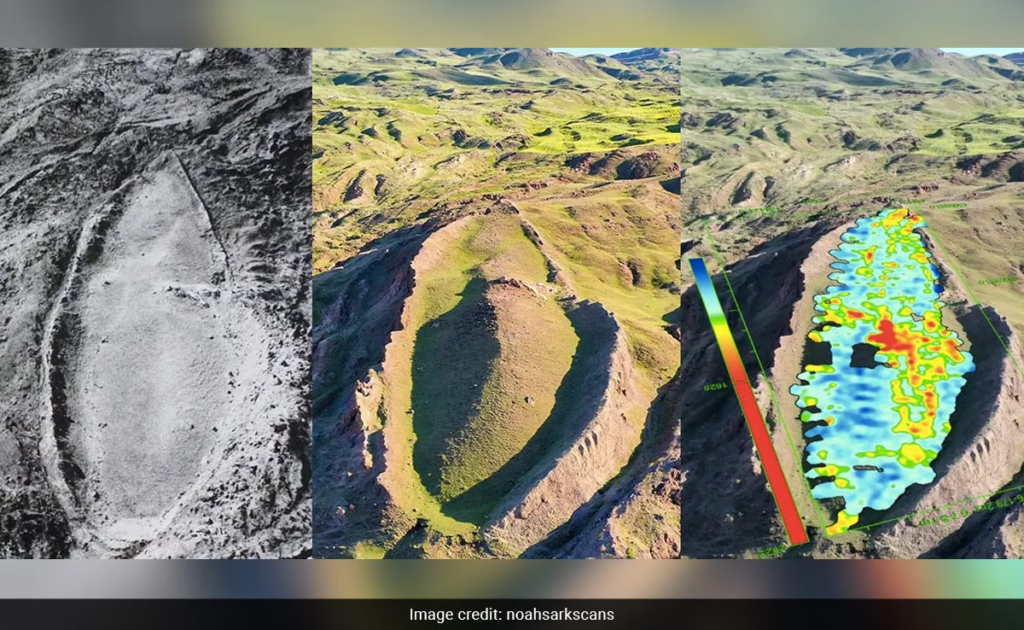Has Noah’s Ark Been Found? New Evidence from Turkey
Recent headlines across major news outlets are reigniting one of the most fascinating archaeological and biblical debates of all time: has Noah’s Ark truly been discovered? Researchers are now pointing to renewed findings from the Durupinar formation in eastern Turkey as possible evidence that the legendary vessel described in the book of Genesis may have left behind physical remnants. The possibility that Noah’s Ark has been found is capturing the attention of both believers and scientists around the world.
The Durupinar Formation: A Mysterious Boat-Shaped Structure
Located near Mount Ararat, the Durupinar formation has long captured global attention due to its unmistakable boat-like shape and massive size – approximately 515 feet, nearly matching the Bible’s description of 300 cubits.
Using advanced ground-penetrating radar and soil analysis, researchers from three Turkish and American universities claim the soil in and around the formation contains higher levels of organic material and potassium, along with lower pH levels, when compared to surrounding terrain. These markers could suggest the decomposition of ancient wood – a potential indicator of human-made structures beneath the surface.

New Techniques, New Possibilities
In 2023 and 2024, researchers used scanning technology and geophysical analysis to peer beneath the surface without excavation. The results? What some scientists describe as anomalous structures and organic traces that might match what you’d expect from a buried wooden ship.
According to reports from NewsNation, Local12, and the New York Post, the technology uncovered patterns that appear to be man-made compartments, consistent with an ancient vessel. The presence of decayed organic material adds to the intrigue.
Why Some Experts Are Still Skeptical
Not all scientists are convinced. Experts from institutions like California State University, Northridge argue that the Durupinar formation is a natural geological formation, and that the organic material could result from natural environmental processes, such as sediment buildup and microbial activity.
No wooden beams, construction fasteners, or definitive artifacts confirming a human-built structure have been excavated. Until such evidence is found, the formation remains unproven as Noah’s Ark, despite the compelling clues.
What This Could Mean for Believers
For many Christians, the story of Noah is a testament to God’s faithfulness, judgment, and mercy. Whether this structure is the Ark or not, the global interest proves the lasting power of God’s Word and the deep yearning to connect our modern world with the eternal truths of Scripture.

A Short Devotional Takeaway
“By faith Noah, when warned about things not yet seen, in holy fear built an ark to save his family.” – Hebrews 11:7 (NIV)
Just as Noah obeyed God even without understanding the full picture, we are called to walk by faith today. Whether the Ark is confirmed or not, what matters most is our trust in God’s promises. Our salvation, just like Noah’s, rests not on what we see, but on who we believe.
A Prayer for Trusting God’s Plan
Heavenly Father,
Thank You for the stories in Scripture that remind us of Your faithfulness. Whether or not we see physical evidence, help us to trust Your Word fully. May our faith be like Noah’s – steadfast, obedient, and anchored in hope.
In Jesus’ Name, Amen.
Frequently Asked Questions (FAQ)
Q: Where is the Durupinar formation located?
A: The Durupinar site is located in eastern Turkey, near Mount Ararat, historically associated with Noah’s Ark.
Q: What kind of technology was used in the latest research?
A: Ground-penetrating radar (GPR), seismic scans, and soil chemistry analysis were used to detect possible man-made formations beneath the surface.
Q: Has definitive proof of Noah’s Ark been found?
A: Not yet. While new evidence suggests the possibility of human activity, no conclusive materials like timber or tools have been recovered.
Q: What does the Bible say about Noah’s Ark?
A: Genesis chapters 6–9 describe God’s command to Noah to build an ark. Preserving life through a worldwide flood as part of His redemptive plan.
Q: Should Christians take this discovery as proof of the Bible’s truth?
A: Faith in God’s Word is not dependent on archaeological proof. Such discoveries can strengthen our understanding and appreciation of biblical history.
Conclusion
The recent findings in Turkey are undoubtedly exciting. They also serve as a reminder: our faith is not built on artifacts, but on the unshakable truth of God’s promises. Stay tuned as researchers continue to explore the Durupinar formation. Whether or not it proves to be the Ark, it is a powerful conversation starter about God’s plan, redemption, and faith.






